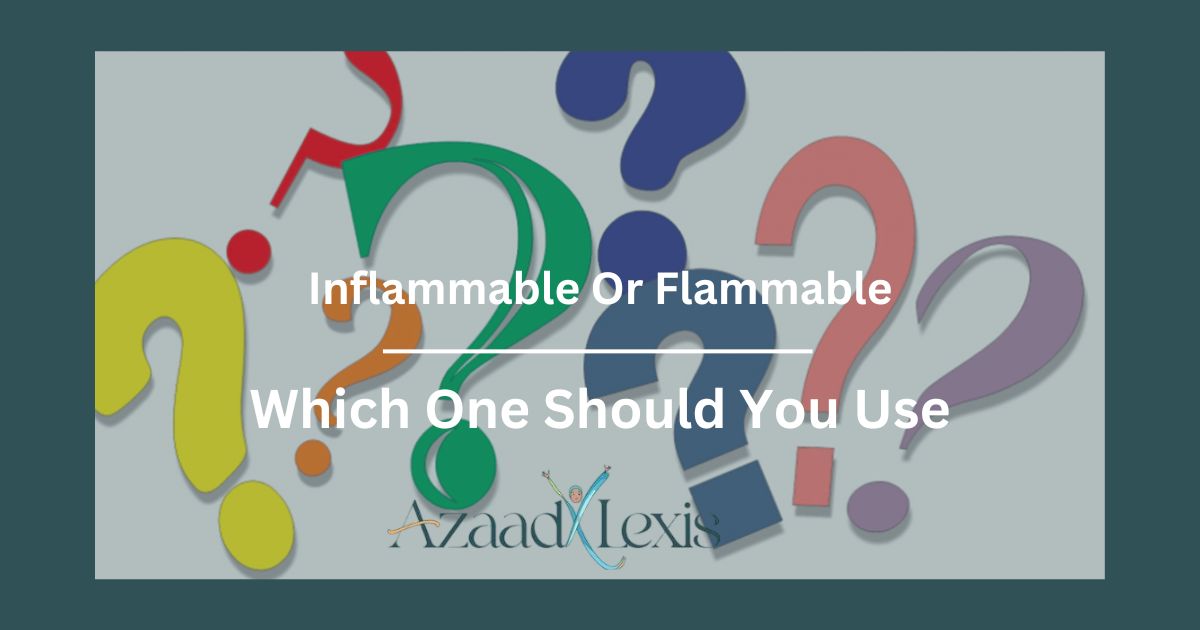Language can be tricky, especially when it comes to words that seem similar but have very different meanings. A common example of such confusion is with the words inflammable. At first glance, these words might seem like opposites, but they have the same meaning.
This article aims to clarify the distinction or lack thereof between these two terms and guide you on when and how to use them correctly.
Understanding Inflammable And Flammable
To comprehend the nuances of inflammable, it’s essential to delve into their definitions and historical usage. Both words describe the potential of a substance to catch fire easily. However, the confusion arises from the prefix “in-” in “inflammable,” which is often interpreted as negating the word it precedes, similar to “invisible” or “incomplete.”
Inflammable: Definition and Usage
Inflammable is derived from the Latin word “inflammare,” which means “to set on fire.” Contrary to what many believe, the “in-” prefix in this case does not imply negation. Instead, it emphasizes the ability to catch fire. Therefore, something inflammable is capable of being easily ignited.
Example Scenario
Consider a warehouse storing large quantities of inflammable materials, such as gasoline or alcohol. A sign reading “No Smoking: Inflammable Materials” is meant to warn workers about the high fire risk. Misunderstanding this word could lead to dangerous situations, as one might incorrectly assume the materials are non-flammable.
Flammable: Definition and Usage
Flammable was introduced more recently to avoid the confusion caused by “inflammable.” It explicitly means that a material can catch fire easily. The use of “flammable” became more widespread in the 20th century, particularly in safety regulations and warning signs, to communicate the risk of combustion.
Example Scenario
Imagine a family barbecue. The label on the charcoal lighter fluid reads flammable, warning users to keep it away from open flames. In this case, the clarity of the term helps ensure users understand the fire hazard.
Side-by-Side Comparison
When comparing inflammable and flammable side by side, the essential takeaway is that they both mean the same thing: capable of catching fire easily. However, flammable is more commonly used today, especially in safety contexts, to eliminate any possible confusion. Here’s a quick breakdown:
- Inflammable: Can catch fire easily (older term, can confuse).
- Flammable: Can catch fire easily (modern term, preferred for clarity).
Read this Blog: Hanged or Hung: Which One Should You Use and Why?
When to Use Inflammable vs. Flammable
Understanding when to use inflammable versus flammable largely depends on your audience and the context. In everyday conversation, technical writing, or safety documentation, flammable is the preferred term. This choice avoids ambiguity and ensures that the message about fire risks is clearly understood.
Example Scenario
A chemistry teacher explaining laboratory safety might opt for flammable when discussing substances like ether or acetone. Using this term helps prevent any misunderstandings among students, especially those unfamiliar with the historical usage of inflammable.
Everyday Usage Examples
To further illustrate how these terms are used in daily life, let’s look at a few practical examples:
- Inflammable in Literature: You might encounter the word inflammable in older texts or literary works. For instance, a novel set in the 19th century might describe a character cautioning against carrying an inflammable lantern oil.
- Flammable in Modern Safety: In contrast, a modern-day instruction manual for a camping stove will likely use the term flammable when discussing the risks of using gas canisters.
- Inflammable in a Historical Context: A historical documentary might mention how inflammable materials contributed to the rapid spread of fires in early urban settings, highlighting the term’s traditional usage.
- Flammable in Emergency Response: Emergency services, such as firefighters, use flammable in their communication to describe materials or conditions that present fire hazards, ensuring clarity and quick understanding.
Conclusion
In conclusion, while inflammable and flammable mean the same thing capable of catching fire easily the preferred term in modern usage is flammable. This change helps to avoid confusion and ensures clear communication, especially in safety-critical situations.
Understanding the history and proper context of these words can help prevent misunderstandings and promote clearer, more effective communication. Whether you encounter these terms in literature, safety instructions, or everyday conversation, knowing their meaning and appropriate usage is crucial.

